target organs
TARGET ORGANS - The key to an effective mycotoxins adsorbent
Some producers consider that mycotoxins are becoming as important as bacterial and viral diseases. This attitude represents a completely different approach to the importance given to mycotoxins in 1987 when we worked with the group lunching the first mycotoxins adsorbent into the global market. At that time most growers considered that mycotoxins did not represent a serious problem.
We should point out that nowadays there are still some producers that confuse mycotoxicosis with viral and bacterial diseases. Part of this problem is due to the lack of access to good diagnostic techniques like histopathology, an excellent tool for the confirmation of the diagnosis. It is important to emphasize that as part of the evaluation of the first absorbents, a key factor in that evaluation was to demonstrate protection of target organs. Table 1 shows the organs most affected by different mycotoxins.
In today's market there has been an influx of products claiming to be effective in controlling the deleterious effects caused by mycotoxins. Some of these products base its effectiveness on marketing campaigns without showing in vitro and/or in vivo results to backup their claims. Some base their efficacy only on in vitro tests or on a positive effect on performance (often without any statistical significant differences) and others on some improvement of the immune response.
Sometimes these positive effects are obtained because of the presence of yeast, beneficial bacteria, enzymes and/or immuno-modulators that are added to the mycotoxins absorbents. These ingredients act to alleviate the secondary effects caused by mycotoxins but have little or no effect on the target organs. Unfortunately few products in the global market have a proven efficacy on the main target organs affected by the mycotoxins against which they are tested.
For the last 2 years the Brazilian government has taken a scientific approach on the approval of mycotoxin binders by evaluating the presence or absence of a statistically significant effect on target organs. LAMIC (Laboratorio de Analisis Micotoxicologicos), under the direction of Dr. Carlos Mallmann, is one key laboratory in charge of this type of tests. So far, few products have passed this strict test (most for aflatoxin) which must be repeated every two years, to demonstrate the product maintains its efficacy. As a result of this novel approach by the Brazilian government, companies are obliged to test their products at LAMIC which now has become one of the top reference laboratories in the world.
If a company claims in his marketing campaign that any of his products has been tested by LAMIC, it does not mean that the absorbent has been approved. Sometimes the results obtained show an improvement in performance, but it is not necessarily related to the protection of the target organs. If any product indicates or suggests a LAMIC approval, it is highly recommendable that you ask for the original study and look at the end of it for a written statement in Portuguese indicating that the product is approved for a 2 - year period.
TARGET ORGAN

Few products have scientific trials showing a positive effect on target organsto support their claims. The following table shows a list of the scientific trials performed with MYCO-AD and MYCO-AD A-Z by
independent Universities and Research Centers around the world.


AFLATOXIN
MYCO-AD effect on liver and size of broilers fed 2.8 ppm of Aflatoxin.

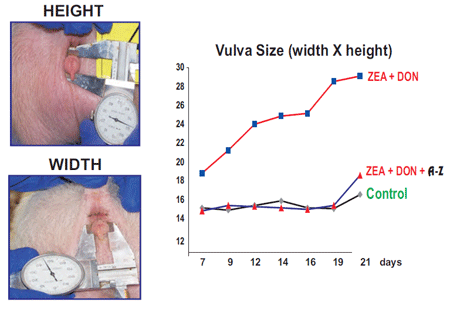
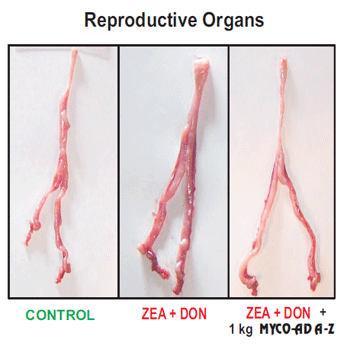
VOMITOXIN (DON)
MYCO-AD A-Z effect on liver and body weight of gilts fed 6 ppm of DON and 1.2 ppm of Zearalenone for 21 days.

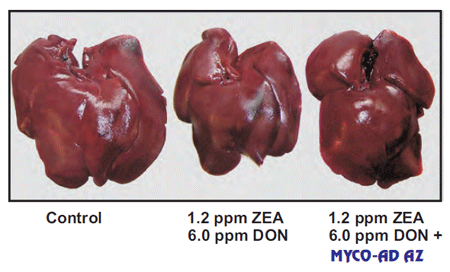
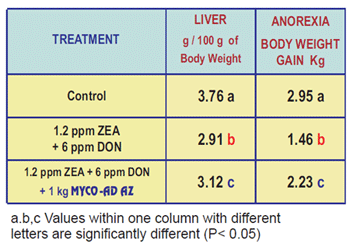
FUMONISIN
MYCO-AD A-Z effect on the lungs of finishing pigs and productivity parameters fed 25 ppm of Fumonisin for 56 days.
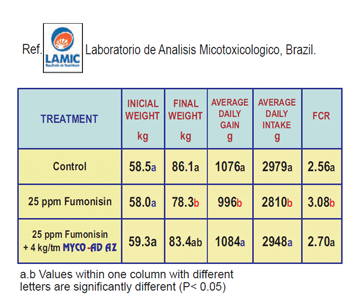


Yes it does
Cotton seed cake contains a free fatty acid cyclopropenoid fatty acids (CPFA) in numerous studies have shown that when both are present, it incrases the toxicity of Aflatoxin.
The other problem is that in many ocasions cotton seed cake contains aflatoxin
Regards
Fernando
The condition of the animal plays a big role on the clinical and subclinical signs
In general
Biomarker: Aflatoxin M1 in milk
A good quality mycotoxin binder will reduce M1 in milk in maximun 24 to 48 hours since the transformation of B1 into M1 is done in 12 hours.
General Regulation
EU max 50 ppt
USA max 500 ppt
Sub clinical/clinical
Increase in Mastitis
Increase in SCC
Decrease in Milk production
Try to avoid using cotton seed cake because it not only ussualy has falatoxin but there is free fatty acid inside of it that increase the toxicity of Aflatoxin
Regards
Fernando
That was a awesome article. Does anyone know how much fraction of mycotoxins can be detoxified in rumainants and poultry?
Good article about effective mycotoxins adsorbent. what are clincial and subclinical signs of AFB1 in ruminants?











